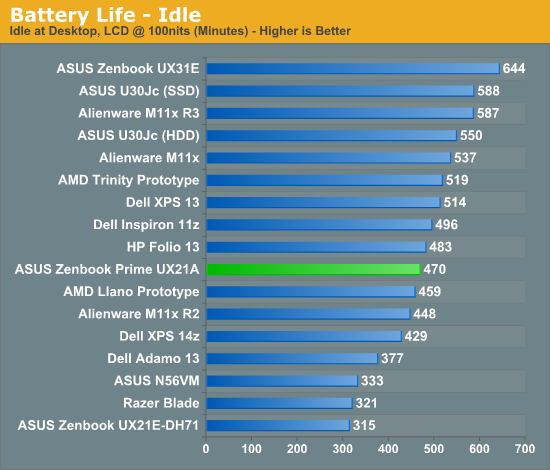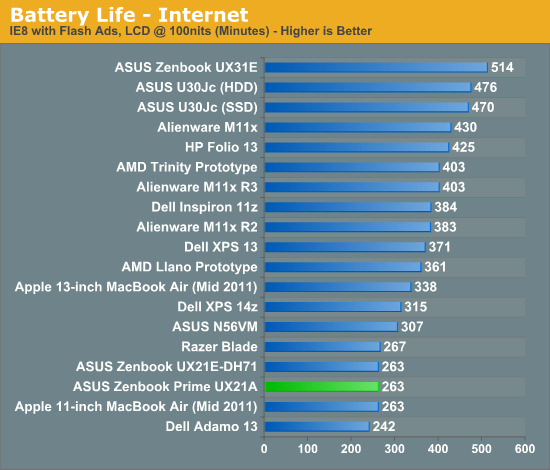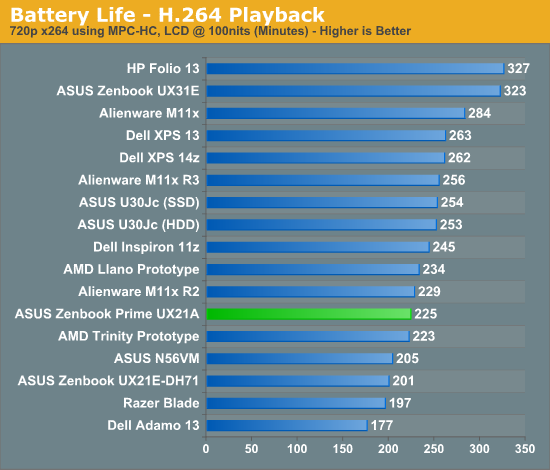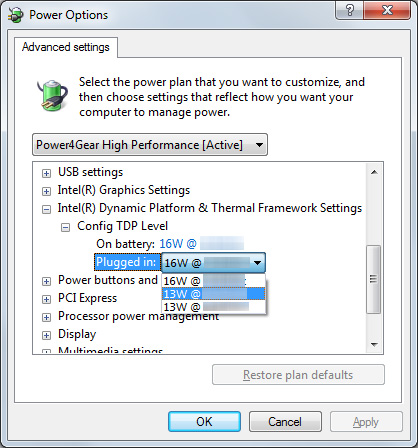ASUS Zenbook Prime (UX21A) Review: The First of the 2nd Gen Ultrabooks
by Anand Lal Shimpi on May 22, 2012 2:46 PM EST- Posted in
- Laptops
- CPUs
- Asus
- Ivy Bridge
- Zenbook
- Zenbook Prime
- Ultrabook
- Notebooks
Battery Life
Generally speaking, the 11-inch Zenbook Prime delivers about the same amount of battery life as its predecessor. For some reason we're able to hit much longer idle battery life on the Prime than the original Zenbook although I'm still trying to find out why. There's also an 11% improvement in our x264 playback test, but on average I'd expect to see similar battery life to the Sandy Bridge model - just with better performance. Note that these results also come despite the fact that ASUS is driving a much higher resolution, and presumably higher power, display than the original Zenbook.



The Zenbook Prime bucks the trend Jarred saw with the first Ivy Bridge notebook review where battery life took a small step backwards. These results bode well for future Ivy Bridge notebooks and Ultrabooks. It still remains to be seen if Intel's 22nm process will actually give us a battery life advantage in any notebook compared to its predecessor. It's possible that we are seeing some of the benefits of 22nm here already and they are simply offset by the more power hungry display. With the move to 22nm Intel should have a better hold on active power and leakage, but it's always possible that we'll have to wait until Haswell for the process to really be exploited.
Just like last time, ASUS has a couple of widgets to quickly change between power settings. The instant on widget lets you switch between suspend to RAM and suspend to disk modes. The former is expected to deliver up to 2 weeks of standby battery life, while the latter can push up to 150 days. I didn't have the time to test these claims (life is short, I draw the line at spending it testing claims of 150 day standby battery life). ASUS once again includes a counter that estimates how long your system will last in either mode based on current charge levels and power usage.
The next widget is a quick tool to let you switch between high performance and battery saver Power4Gear power profiles. You can customize these profiles via the Windows control panel, but it's nice to have a button on the desktop that lets you quickly switch between them.
Configurable TDP
One feature of Ivy Bridge that we haven't been able to test until now is configurable TDP. While most Ultrabook CPUs ship with a 17W TDP, that's mostly an arbitrary thermal/power rating. If an OEM wants to design a chassis that can only accept a 13W part it previously had to hope that Intel would make such a thing. Alternatively, the OEM could underclock/undervolt a 17W chip on their own and hope to mimic Intel's validation and deliver a 13W configuration of their own. The former requires that a significant number of OEMs demand the part, while the latter is just too risky for the larger OEMs (get too aggressive on the undervolting side and end up with a bunch of unstable systems). The solution Intel proposed with Ivy Bridge is configurable TDP. For Ultrabooks this means you can set a 17W part to 13W.

Currently the setting is hidden away in Windows 7's power management settings. Once again I've had to censor the clock speeds here due to Intel's Ultrabook embargo:
You can map the 13W settings to the battery saver profile and then, at the click of a button, have a 13W Zenbook Prime instead of a 17W model. The difference in performance isn't significant however:
| ASUS Zenbook Prime Configurable TDP Performance - Cinebench 11.5 (Multithreaded) | |||||||
| 16W - Max Freq | 13W - Mid Freq | 13W - Lowest Freq | |||||
| ASUS Zenbook Prime UX21A | 2.79 | 2.67 | 2.67 | ||||
I'm still running battery life tests to quantify the impact on power consumption, but it's conceptually a neat thing to see in action finally. I suspect configurable TDP is going to play a major role with Haswell and convertible/dockable Ultrabook-tablet hybrids.
Thermals and Noise
As with most high performance notebooks that are this thin, cooling is difficult. Under load the fans in the Zenbook Prime are definitely audible, but in general ASUS does a better job cooling everything inside the Zenbook Prime than Apple does in the MacBook Air. I suspect much of this boils down to how aggressive Apple is about keeping fan speed/noise down compared to ASUS' desire to maintain a certain temperature level inside the chassis.










192 Comments
View All Comments
haukionkannel - Tuesday, May 22, 2012 - link
It is very nice to see much better panels in these new laptops! And when you think how much power good display eats it is guite nice to see that powr usage has remained the same! We will get more clarity to this matter when ux32 will be released. It seems to have that normal pitifull low res TN panel like in most old laptops...We need more laptops like these! I would not mind to see a little bit bigger case with these panels at a little bit lover price!
phoenix_rizzen - Tuesday, May 22, 2012 - link
The high-end version of the UX32, with the discrete GPU, has the same 1920x1080 IPS panel. But the battery is slightly smaller (48 Whr vs 50 Whr).Conficio - Wednesday, May 23, 2012 - link
I'd go for the UX32 if there would an option with a good screen that is not combined with a useless (to me) gamers GPU.Although I don't understand the pricing $200 buy me just a faster CPU? Really, that has to be a really big jump for that kind of premium
Then the next $300 buy me a decent display (it's still 16:9 and should be 16:10 for people that actually work on their computers, as opposed to entertainment) and a GPU?
Why can't we have a reasonable upgrade (<$75) for the display with the lower end CPUs. I'd think the $1,000 price point should actually include the nicer display.
B3an - Tuesday, May 22, 2012 - link
So nice to see a GOOD 1080p IPS display on this. And the rest of the package looks great too, might actually get one of these but would have liked atleast 6GB.tipoo - Tuesday, May 22, 2012 - link
Does that lift before the shipping date? If so, when? Odd that they would be hush hush about that, maybe they are having thermal issues since apparently IB runs hotter than SB.Evil_Sheep - Tuesday, May 22, 2012 - link
Oh wow this model is a dream come true. It's been years but has a PC vendor finally got what it takes to go head to head with Apple?Roland00Address - Tuesday, May 22, 2012 - link
Nobody uses that port, and while it comes with a dongle you could have used mini displayport or thunderbolt and achieve the same vga effect with mini displayport to vga dongle.That said this is a beauty of a laptop.
fic2 - Tuesday, May 22, 2012 - link
I don't know, but I would assume they included it for projector systems. I think most of the conference rooms in the building I work in only have vga to the table.fic2 - Tuesday, May 22, 2012 - link
My fail - didn't read the rest of your post about DP->vga dongle.ananduser - Tuesday, May 22, 2012 - link
My dear Anand, you're so pretentious with displays in general but when it comes to gaming fluency you go below standard. 20fps is NOT playable and a subpar experience. I'd wish you'd be as pretentious with GPU performance as you are with hardware specs.